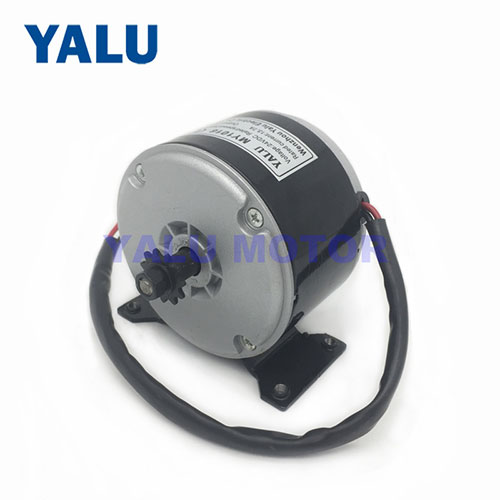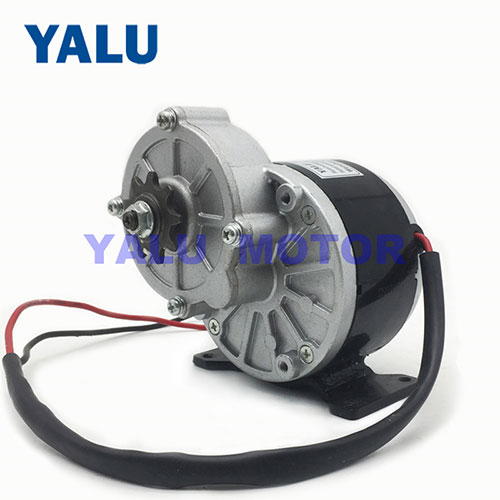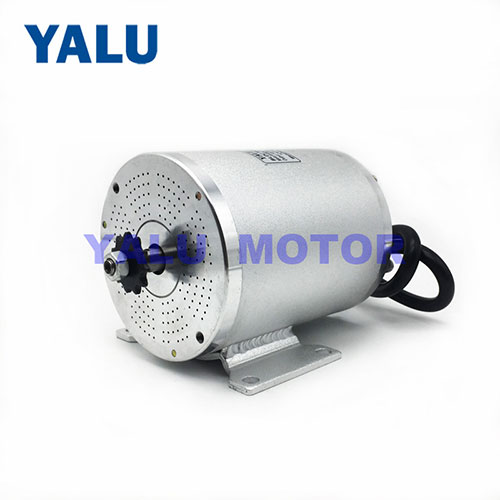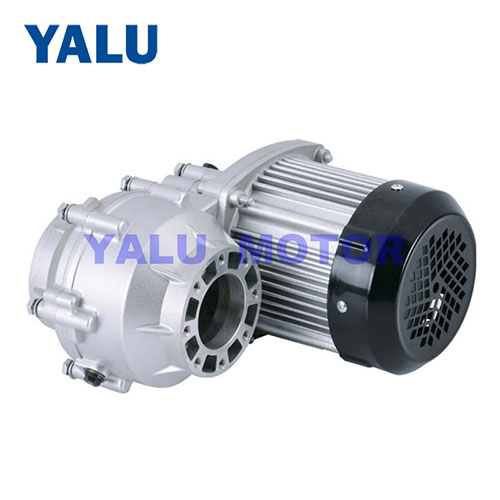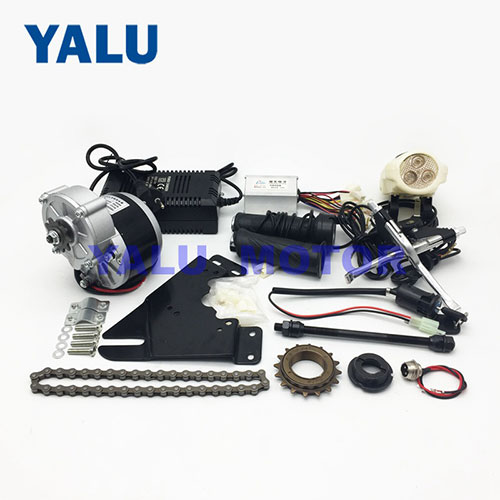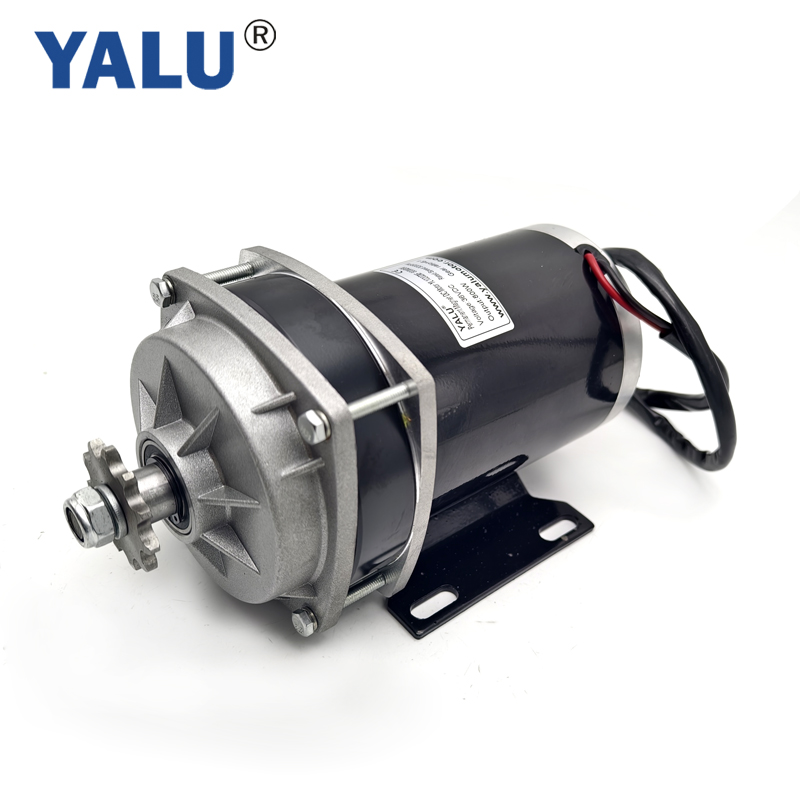Firstly, the working principle of brushed motor and brushless motor is introduced. Finally, the difference between the working principle of brushed DC motor and brushless DC motor is explained in detail from the two aspects of speed regulation and performance difference.
The working principle of brushed motor and brushless motor
1.brushed motor
When the motor is working, the coil and the commutator rotate, but the magnetic steel and the carbon brush do not rotate. The alternating change of the current direction of the coil is accomplished by the commutator and brush that rotate with the motor. In the electric vehicle industry, brushed motors are divided into high-speed brushed motors and low-speed brushed motors. There are many differences between brushed motors and brushless motors. From the name, it can be seen that brushed motors have carbon brushes, and brushless motors do not have carbon brushes.
The brush motor consists of two parts: stator and rotor. The stator has magnetic poles (winding type or permanent magnet type), and the rotor has windings. After electrification, a magnetic field (magnetic pole) is also formed on the rotor. There is a magnetic pole between the stator and the rotor. The included angle makes the motor rotate under the mutual attraction of the stator and rotor magnetic fields (between the N pole and the S pole). By changing the position of the brush, the angle between the stator and rotor magnetic poles can be changed (assuming that the magnetic pole of the stator starts from the angle, the magnetic pole of the rotor is on the other side, and the direction from the magnetic pole of the rotor to the magnetic pole of the stator is the direction of rotation of the motor) direction, thereby changing the direction of rotation of the motor.
2.brushless Motor
The brushless motor adopts electronic commutation, the coil does not move, and the magnetic pole rotates. The brushless motor uses a set of electronic equipment to sense the position of the magnetic pole of the permanent magnet through the Hall element. According to this perception, the electronic circuit is used to switch the direction of the current in the coil in time to ensure that the magnetic force in the correct direction is generated to drive the motor. . Eliminates the disadvantages of brushed motors.
These circuits are the motor controllers. The controller of the brushless motor can also realize some functions that the brushed motor cannot, such as adjusting the power switching angle, braking the motor, reversing the motor, locking the motor, and using the brake signal to stop the power supply to the motor. Now the electronic alarm lock of the battery car makes full use of these functions
A brushless DC motor consists of a motor body and a driver, and is a typical mechatronic product. Because the brushless DC motor runs in a self-controlled manner, it will not add a starting winding to the rotor like a synchronous motor with heavy load starting under variable frequency speed regulation, nor will it cause oscillation and loss of step when the load changes suddenly.
Detailed explanation of the difference between brushed motor and brushless motor
一.The difference in speed regulation
In fact, the control of the two motors is voltage regulation, but because the brushless DC adopts electronic commutation, it can only be realized with digital control, while the brushed DC is commutated through carbon brushes, using thyristors, etc. Traditional analog circuits can be controlled, which is relatively simple.
1.The brushed motor speed regulation process is to adjust the level of the motor power supply voltage. The adjusted voltage and current are converted through the commutator and the brush to change the strength of the magnetic field generated by the electrode, so as to achieve the purpose of changing the speed. This process is called variable speed regulation.
2.The brushless motor speed regulation process is that the voltage of the motor's power supply remains unchanged, the control signal of the ESC is changed, and the switching rate of the high-power MOS tube is changed by the microprocessor to achieve the change of the speed. This process is called variable frequency speed regulation.
二.performance difference
1.The brushed motor has a simple structure, a long development time and advanced technology.
Brushed motors are traditional products with relatively stable performance. The brushless motor is an upgraded product, and its life performance is better than that of the brushed motor. However, its control circuit is more complex, and the requirements for aging screening of components are relatively strict.
Soon after the brushless motor was born, people invented the DC brush motor. Due to the simple structure of the DC brush motor, the production and processing are easy, the maintenance is convenient, and the control is easy; the DC motor also has a fast response, a large starting torque, and can provide rated torque from zero speed to rated speed. has been widely used.
2.DC brush motor has fast response speed and large starting torque
The DC brush motor has fast starting response speed, large starting torque, stable speed change, almost no vibration from zero to maximum speed, and can drive a larger load when starting. The brushless motor has a large starting resistance (inductive reactance), so the power factor is small, the starting torque is relatively small, there is a humming sound when starting, accompanied by strong vibration, and the driving load is small when starting.
3.DC brush motor runs smoothly, with good starting and braking effects
The brushed motor adjusts the speed through voltage regulation, so the starting and braking are stable, and the constant speed operation is also stable. The brushless motor is usually controlled by digital frequency conversion, which first converts AC into DC, then DC into AC, and controls the speed through frequency changes, so the brushless motor does not run smoothly during starting and braking, and the vibration is large, only when the speed is constant. will be stable.
4.DC brush motor with high control accuracy
The DC brush motor is usually used together with the reduction box and the decoder, so that the output power of the motor is larger, and the control accuracy is higher. The control accuracy can reach 0.01 mm, and the moving parts can be stopped almost anywhere. All precision machine tools are controlled by DC motors for precision. Because the brushless motor is not stable when starting and braking, the moving parts will stop to different positions each time, and the positioning pins or limiters must be used to stop at the desired position.
5.The DC brush motor has low cost of use and easy maintenance.
Due to the simple structure, low production cost, many manufacturers, and relatively mature technology, DC brushed motors are widely used, such as factories, processing machine tools, precision instruments, etc. If the motor fails, just replace the carbon brush. Carbon brushes only cost a few dollars, which is very cheap. The brushless motor technology is immature, the price is high, and the application range is limited. It should be mainly used on constant-speed equipment, such as inverter air conditioners, refrigerators, etc., and the brushless motor can only be replaced if it is damaged.
6.Brushless, low interference
The brushless motor removes the brush, and the most direct change is that there is no electric spark generated when the brushed motor is running, which greatly reduces the interference of the electric spark to the remote control radio equipment.
7.Low noise and smooth operation
The brushless motor has no brushes, the friction force is greatly reduced during operation, the operation is smooth, and the noise will be much lower. This advantage is a huge support for the stability of the model.
8.Long life and low maintenance costs
Without the brush, the wear of the brushless motor is mainly on the bearing. From a mechanical point of view, the brushless motor is almost a maintenance-free motor. When necessary, only some dust removal maintenance can be done.The brushless motor can work continuously for about 20,000 hours, and the conventional service life is 7-10 years. Carbon brush motor: It can work continuously for about 5000 hours, and the normal service life is 2-3 years.
9.different applications
Brushless motor equipment can be used in: dairy industry, brewing industry, meat processing industry, soy product processing industry, beverage processing industry, pastry processing industry, pharmaceutical industry, electronic precision factory, and other dust-free workshops with higher requirements Wait, like the brushless motor (DIHOUR) hand dryer produced by Dior Electric, it is used more in factories

 EN
EN 中文
中文